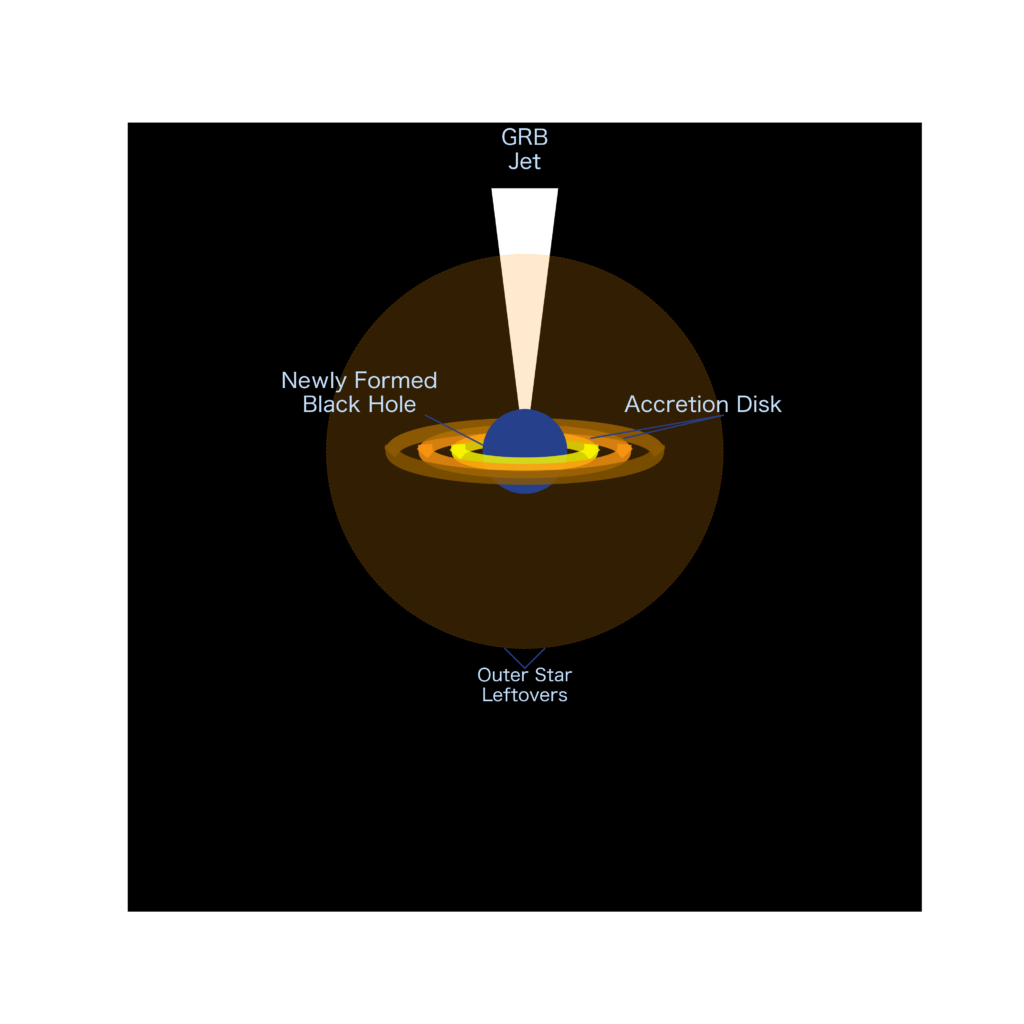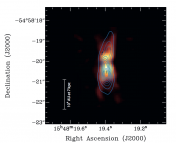Title: GRB 221009A: Discovery of an Exceptionally Rare Nearby and Energetic Gamma-Ray Burst
Authors: Maia A. Williams, Jamie A. Kennea, S. Dichiara, Kohei Kobayashi, Wataru B. Iwakiri et al.
What is a Gamma Ray Burst?
Gamma Ray Bursts (GRBs) are the extremely violent expulsion of gamma rays in a sudden ‘burst’, as a jet. These come in two flavors: short (lasting less than 2 seconds) and long (lasting more than 2 seconds) GRBs. Though it is still unclear exactly what causes GRBs, it is expected that neutron star mergers create short GRBs and collapsars create long GRBs. In this astrobite, we will focus on long GRBs and collapsars.
A collapsar is when a very massive star (mass > 20 solar mass) undergoes core collapse. It is expected that such stars are so massive that rather than a core collapse supernova (which is when a star with 8 solar mass < M < 20 solar mass collapses and explodes as a result; here’s an awesome bite about these stars!), when these stars die, they collapse directly into a black hole. When such a collapse happens, the central part of the star collapses into a black hole, while the material in the outer regions of the star form an accretion disk around the black hole. This accretion disk produces a very strong relativistic jet, creating a GRB. If this jet happens to be pointed towards the Earth, we will detect the gamma rays from the GRB. Usually one sees a brief flash of these gamma rays, followed by an afterglow that can be seen in many other bands of the electromagnetic spectrum (X-ray, UV, optical, IR, and radio). As this jet of gamma rays start pouring into the surrounding regions of the star, they start interacting with the surrounding interstellar material, which we see as the afterglow. Figure 1 shows a schematic diagram of what such a jet from an accretion disk around a black hole looks like in such a system.

The authors of this paper present GRB 221009A, a long GRB detected in October of 2022, and was observed by the NASA Swift satellite, a space telescope that can detect X-ray, UV, and optical photons.
What was GRB 221009A?
First, let’s talk about the name: GRB 221009A. How do we name these objects? The “GRB” part refers to the type of object – a GRB. The numbers 221009 refer to the date it was discovered: October 9 2022. The ‘A’ refers to the order in which it was discovered that day. Put all together, GRB 221009A was the first GRB detected on October 9 2022.
This GRB was detected at cosmological redshift (z) of 0.151 in the plane of the galaxy. Figure 2 shows the soft x-ray (0.3-10 keV photons) luminosity on the vertical axis and time on the horizontal axis (a light curve) for this GRB as observed by Swift, along with all the other GRBs observed by swift in orange, purple, and grey. This shows that the GRB is among the brightest ones we have seen before.

Because brighter GRBs are less common than fainter ones, the bright ones we do see are usually much farther away. In fact, most of the grey GRBs in figure 1 are at much higher redshift than 0.3, making GRB 1009A a strangely nearby and very luminous GRB. In fact, by accounting for how rarely such bright GRBs have been detected by Swift and how much of the entire sky is visible to the instrument at a given time, these authors estimate that we would have to wait another 17 years to see another GRB 1009A-like event again from anywhere in the universe, and for over 1000 years to see another GRB 1009A-like event this nearby!! GRB 221009A is truly a one in a lifetime phenomenon!
Seeing Dust Rings with the GRB
Because this GRB happened in the plane of the galaxy, photons that are emitted by the GRB have to travel through a lot of the dust that sits in the galaxy before they become visible to our instruments. Therefore, when observing x-ray photons that travel through the galactic plane, one can do dust echo tomography to measure distances to dust clouds geometrically.
When light from the GRB is absorbed by the intervening dust particles (see figure 3), they re-emit that light in random directions. This new light is then absorbed by the surrounding ring structure, which will eventually emit light towards the Earth. The time delay between when we see light from the GRB and light from the dust rings tells us how long it takes for light to travel from the center of the rings to the outskirts, which we can use to find the size of the rings. We can then use this measurement to find the distance to the rings. Using this method, the authors find there are rings at 200, 400, 600, and 700 pc in the direction of this GRB.

The authors think the bumps in the light curve are caused by the supernova’s ejecta interacting with circumstellar mass (CSM), created by layers of mass that were burped off by the star during pulsations. As the ejecta leaves from the star’s surface, it passes through multiple layers of CSM, each of which creates a shockwave, resulting in a bump in the light curve.
Future Avenues
This GRB truly is a unique event that will lead to much new science in the coming months. There have already been several papers about the GRB, focusing on the GRB-specific science (cite) and on the accompanying supernova (cite). In addition, following up more GRBs like this one will finally shed light on the difference between long and short GRBs, along with our understanding what may actually cause them.
Astrobite edited by Clarissa Do O
Featured image credit: Karthik Yadavalli




